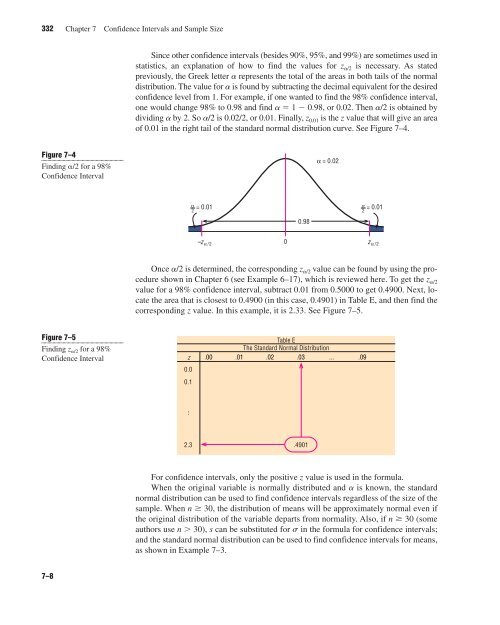Confidence Intervals and Sample Size
Confidence Intervals and Sample Size
Confidence Intervals and Sample Size
Create successful ePaper yourself
Turn your PDF publications into a flip-book with our unique Google optimized e-Paper software.
lu49076_ch07.qxd 5/20/2003 3:15 PM Page 332<br />
332 Chapter 7 <strong>Confidence</strong> <strong>Intervals</strong> <strong>and</strong> <strong>Sample</strong> <strong>Size</strong><br />
Figure 7–4<br />
Finding �/2 for a 98%<br />
<strong>Confidence</strong> Interval<br />
Figure 7–5<br />
Finding z �/2 for a 98%<br />
<strong>Confidence</strong> Interval<br />
7–8<br />
Since other confidence intervals (besides 90%, 95%, <strong>and</strong> 99%) are sometimes used in<br />
statistics, an explanation of how to find the values for z a/2 is necessary. As stated<br />
previously, the Greek letter a represents the total of the areas in both tails of the normal<br />
distribution. The value for a is found by subtracting the decimal equivalent for the desired<br />
confidence level from 1. For example, if one wanted to find the 98% confidence interval,<br />
one would change 98% to 0.98 <strong>and</strong> find a � 1 � 0.98, or 0.02. Then a/2 is obtained by<br />
dividing a by 2. So a/2 is 0.02/2, or 0.01. Finally, z 0.01 is the z value that will give an area<br />
of 0.01 in the right tail of the st<strong>and</strong>ard normal distribution curve. See Figure 7–4.<br />
α<br />
2<br />
= 0.01<br />
α = 0.02<br />
α = 0.01<br />
2<br />
–z α /2<br />
0<br />
z α /2<br />
Once a/2 is determined, the corresponding z a/2 value can be found by using the procedure<br />
shown in Chapter 6 (see Example 6–17), which is reviewed here. To get the z a/2<br />
value for a 98% confidence interval, subtract 0.01 from 0.5000 to get 0.4900. Next, locate<br />
the area that is closest to 0.4900 (in this case, 0.4901) in Table E, <strong>and</strong> then find the<br />
corresponding z value. In this example, it is 2.33. See Figure 7–5.<br />
z<br />
0.0<br />
0.1<br />
...<br />
2.3<br />
For confidence intervals, only the positive z value is used in the formula.<br />
When the original variable is normally distributed <strong>and</strong> a is known, the st<strong>and</strong>ard<br />
normal distribution can be used to find confidence intervals regardless of the size of the<br />
sample. When n � 30, the distribution of means will be approximately normal even if<br />
the original distribution of the variable departs from normality. Also, if n � 30 (some<br />
authors use n � 30), s can be substituted for s in the formula for confidence intervals;<br />
<strong>and</strong> the st<strong>and</strong>ard normal distribution can be used to find confidence intervals for means,<br />
as shown in Example 7–3.<br />
0.98<br />
Table E<br />
The St<strong>and</strong>ard Normal Distribution<br />
.00 .01 .02 .03 ... .09<br />
.4901

















